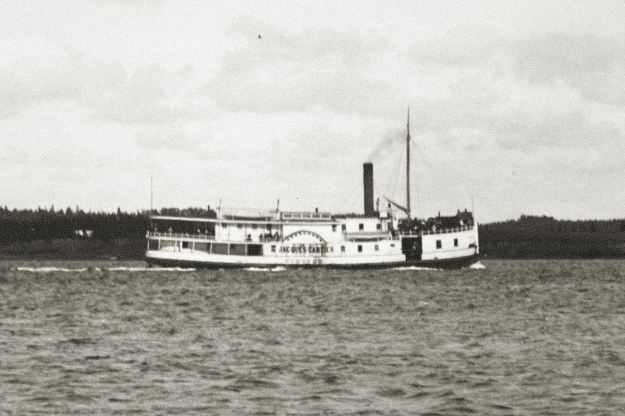Although it was late in the season it was simply a routine trip. Every Friday the S.S. Jacques Cartier left the wharf in Charlottetown and headed out the mouth of the Harbour for Victoria, as the port for Crapaud was becoming known. On 28 November 1902 as she passed Blockhouse Light she was carrying no passengers but had a crew, of seven and a full cargo as merchants from Victoria through to Kelly’s Cross tried to get stock to tide them over during the period when the port was iced-up and the land travel was slow and difficult.
The Jacques Cartier had boots, iron and cloth for Wright Brothers in Victoria, washing sod and wool for the Tryon Woolen Mills, egg cases and nails for Wadman’s in Crapaud, oil turpentine and forks for P.G. Lord in Tryon, carriage stock for Charles McKenna and Patrick Trainor, both in Kelly’s Cross and items including soap, oysters, raisins, cider, tobacco, apples, confectionary and potash for a number of other dealers and individuals. It was a trip like any other.
 Except… it was almost the beginning of December and the weather could turn at any time. In hindsight the Guardian was to recall that many were distrustful of the fourteen year old side-wheeler as she had been built for inland use and might have a bad time with a storm in open water. The Jacques Cartier was built in Quebec in 1888 and acquired in 1892 at a cost of $13,000 by the Inland Steam Navigation for the river and bay service which linked Charlottetown with West River, Mt. Stewart, Orwell and Victoria. She was reasonably sized for the service at 120 feet by 23 feet breadth. Like many side-wheeler she had a beam engine turning the paddles from a single 30 inch cylinder with a six-foot stroke.
Except… it was almost the beginning of December and the weather could turn at any time. In hindsight the Guardian was to recall that many were distrustful of the fourteen year old side-wheeler as she had been built for inland use and might have a bad time with a storm in open water. The Jacques Cartier was built in Quebec in 1888 and acquired in 1892 at a cost of $13,000 by the Inland Steam Navigation for the river and bay service which linked Charlottetown with West River, Mt. Stewart, Orwell and Victoria. She was reasonably sized for the service at 120 feet by 23 feet breadth. Like many side-wheeler she had a beam engine turning the paddles from a single 30 inch cylinder with a six-foot stroke.
She had been spotted off Hampton, not far from the end of her run to Victoria and apparently on schedule at half-past four on Friday night and fighting a rising north-west gale when the light dimmed and she slipped from sight. She never arrived in Victoria. But the problem was not the gale. The problem was that the Jacques Cartier had lost her rudder and no matter how seaworthy the boat and how powerful her engines. if she could not control where she was headed the wind and tide would make decisions for her.
A little more than 20 nautical miles to the south-west of Hampton and Victoria lies Cape John, Nova Scotia. The night would have been an anxious one for those aboard. There is a dangerous reef at Amhet Island and the northern Nova Scotia coast is not a welcoming one. Even with the ability to steer it is not an area where Captain David Walker would want to have been.
The news arrived by telegram in Charlottetown on Saturday. The Jacques Cartier was ashore. The crew had been saved but the vessel was a total loss.
After her demise the Guardian concluded that replacement would be difficult. “The service is one that cannot be dispensed with and yet the traffic is hardly sufficient to maintain a fast or expensive boat.” There would have been no service at all but for the provincial government subsidy and in 1901 she was laid up for a few months as the company tried to negotiate a more profitable schedule. The Jacques Cartier had been put up for auction by her owners in 1897. A the time of her loss the principle shareholders were L.L. Beer, Benjamin Rogers and William Welsh. She was not irreplaceable and the following year the S.S. City of London appeared on the route


Can you send me an email at scotts@pei.sympatico.ca I have a photo that you might be interested in – Ian Scott
Pingback: Lost in the Fog – The sinking of the Steamer Heather Belle | Sailstrait
Pingback: The Paddle-steamer Jacques Cartier | Sailstrait
Pingback: The City of London | Sailstrait
Pingback: Later ferries the Elfin and the Southport | Sailstrait
Pingback: Jacques Cartier Vessel Wrecked at Cape John, NS, November 28, 1902 – Our Island Climate